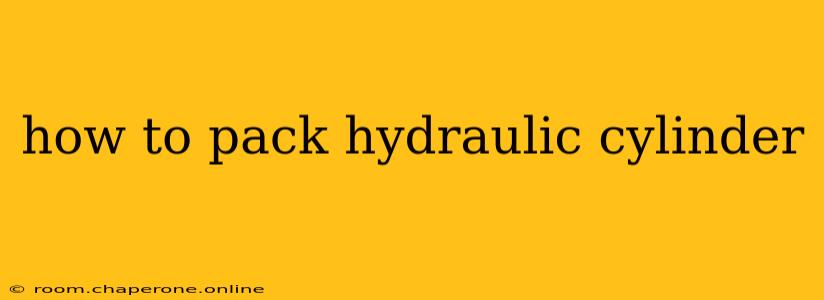Packing a hydraulic cylinder might seem daunting, but with the right knowledge and tools, it's a manageable task. This comprehensive guide breaks down the process, covering everything from preparation to final checks, ensuring a properly sealed and functioning hydraulic system. Improper packing can lead to leaks, reduced efficiency, and ultimately, costly repairs. This guide will help you avoid those pitfalls.
Understanding Hydraulic Cylinder Packing
Before diving into the process, let's understand the importance of proper packing. The packing seals the piston rod, preventing hydraulic fluid from leaking. Different types of packing materials exist, each suited for specific applications and operating conditions. Common materials include leather, polyurethane, and various types of synthetic rubber. The choice of packing material depends on factors such as the operating pressure, temperature, and the type of hydraulic fluid used.
Tools and Materials You'll Need
Before you begin, gather all the necessary tools and materials:
- New packing set: Ensure you have the correct type and size of packing rings for your specific cylinder. Refer to your cylinder's specifications or consult with a hydraulics specialist if unsure.
- Packing gland nut wrench: This specialized wrench prevents damage to the gland nut during tightening.
- Hammer and drift punch: Used for carefully seating the packing rings.
- Hydraulic cylinder disassembly tools: These may vary depending on the cylinder design but could include wrenches, sockets, and pullers.
- Clean rags or shop towels: Essential for keeping the cylinder clean and preventing contamination.
- Penetrating oil: Helps loosen any stuck or corroded parts.
- Measuring tools: Calipers or a ruler to ensure accurate packing ring installation.
- Lubricant: Suitable for the packing material and hydraulic fluid. Check the manufacturer's recommendations.
- Safety glasses and gloves: Always prioritize safety.
Step-by-Step Guide to Packing a Hydraulic Cylinder
This process is best suited for those with some mechanical experience. If you are uncomfortable working with hydraulic equipment, consult a qualified professional.
1. Preparation and Disassembly
- Safety First: Disconnect the hydraulic power source completely before starting.
- Clean the area: Remove any debris or dirt around the cylinder.
- Disassemble the cylinder: Carefully remove the gland nut, gland, and existing packing. Note the arrangement and orientation of the existing packing for reference during reassembly. Take pictures if it helps.
- Clean the cylinder: Thoroughly clean the cylinder bore and piston rod to remove any dirt, old packing debris, or corrosion.
2. Installing the New Packing
- Lubricate the packing: Apply a thin layer of lubricant to the new packing rings. This aids in installation and reduces friction.
- Install the packing rings: Carefully insert the packing rings into the gland, ensuring they are properly seated and aligned. Refer to the manufacturer's instructions or diagram for the correct orientation and arrangement of the rings. Avoid compressing them excessively during installation.
- Install the gland: Replace the gland, ensuring it's correctly aligned.
3. Gland Nut Tightening
- Tighten the gland nut: Use the gland nut wrench to tighten the nut gradually and evenly. Do not overtighten, as this can damage the packing or the cylinder. Tighten until the packing is compressed sufficiently to create a proper seal but not excessively. A slight resistance to turning the piston rod is normal.
- Check for leaks: Once tightened, carefully operate the cylinder through its full range of motion, checking for any leaks.
4. Final Checks and Reassembly
- Inspect for leaks: Thoroughly inspect the area around the packing for any leakage. Small leaks may appear initially but should diminish as the packing settles.
- Reassemble the cylinder: Reassemble all components, ensuring proper alignment and function.
- Test the cylinder: Reconnect the hydraulic power source and thoroughly test the cylinder’s operation, observing for leaks or unusual behavior.
Troubleshooting Common Issues
- Leaks: If leaks persist, the packing might be incorrectly installed, damaged, or the wrong type for the application.
- Stiff piston rod: Overtightening the gland nut can cause the piston rod to become stiff. Loosen the gland nut slightly and test.
- Excessive wear: If the packing wears out quickly, it might indicate improper lubrication, excessive pressure, or contamination in the hydraulic fluid.
By following these steps and paying attention to detail, you can successfully pack a hydraulic cylinder and restore its functionality. Remember, safety is paramount throughout this process. If at any point you feel unsure, consult a hydraulics professional. They possess the specialized knowledge and tools for complex repairs.

